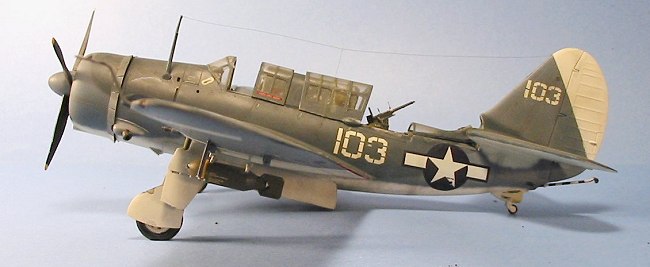
|
KIT: |
Promodeler 1/48 SB2C-5 |
|
KIT # |
5935 |
|
PRICE: |
@$25.00 |
|
DECALS: |
Two Aircraft |
|
REVIEWER: |
Tom Cleaver |
|
NOTES: |
Updated from -4 version |

|
HISTORY |
The Curtiss-Wright SB2C "Helldiver" was to be the U.S. Navy's definitive dive bomber in what everyone in the Navy expected would be the coming war with Japan. The SB2C was the winner of a 1938 Navy design competition that required the airplane to have an internal bomb bay capable of carrying 2,000 pounds of bombs, and an airframe that would be able to ride a carrier elevator that was 40' x 48' - the dimensions of the coming "Essex" class of fleet carriers. This was a formidable challenge, to design an airplane with sufficient performance, and keep its size down to such dimensions. For Curtiss, the airplane was to be the fulfillment of all the "Helldivers" that had come before it, beginning with the F8C in 1931, and was to be markedly superior to the Douglas SBD "Dauntless" that was just coming off the drawing boards in late 1938.
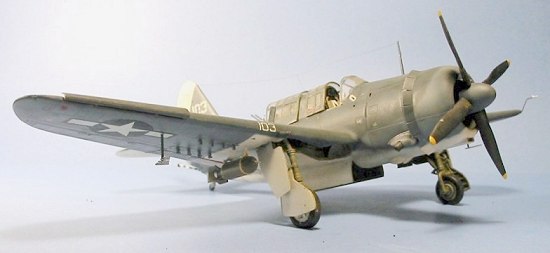 The result was a
short-coupled airplane that would finally grow a huge vertical fin and rudder,
as well as oversized horizontal stabilizer and elevators, in order to provide
sufficient control in a fuselage as short as that in the SB2C. Originally,
the SB2C was to have a power-operated turret like that in the contemporary
Grumman TBF Avenger; fortunately, the Navy deleted that requirement.
The result was a
short-coupled airplane that would finally grow a huge vertical fin and rudder,
as well as oversized horizontal stabilizer and elevators, in order to provide
sufficient control in a fuselage as short as that in the SB2C. Originally,
the SB2C was to have a power-operated turret like that in the contemporary
Grumman TBF Avenger; fortunately, the Navy deleted that requirement.
Because of the looming war, the SB2C would be one of the first designs to be ordered into production "off the drawing board," before the flight of the first prototype. 370 SB2C-1s were ordered May 15, 1939. due to Curtiss' commitments for the P-40 at the Buffalo plant, a new plant in Columbus, Ohio had to be built to handle production of the Helldiver while the first prototype was being built.
The design was far from ready for any sort of production. Wind tunnel tests revealed the original wing design had a stalling speed that was far too high for a carrier-based aircraft; this resulted in a redesign (and concomitant delay) that increased the total wing area by 10 percent, while Handley-Page slats were added for low-speed controllability.
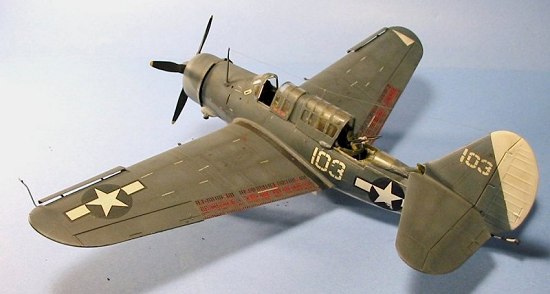 The XSB2C-1 rolled
out on December 13, 1940, and first flew on December 18. Test pilot Lloyd
Childs reported that the predicted stability problems had not been solved,
though they had been somewhat mollified. The crash of the prototype in
February 1941 set the program back while it was rebuilt, with test flying
resuming in May 1941, with a larger - though not yet definitive - tail. The
wing failed in flight on December 21, 1941, destroying the prototype before it
could undergo Navy trials.
The XSB2C-1 rolled
out on December 13, 1940, and first flew on December 18. Test pilot Lloyd
Childs reported that the predicted stability problems had not been solved,
though they had been somewhat mollified. The crash of the prototype in
February 1941 set the program back while it was rebuilt, with test flying
resuming in May 1941, with a larger - though not yet definitive - tail. The
wing failed in flight on December 21, 1941, destroying the prototype before it
could undergo Navy trials.
The first production SB2C-1 rolled out on June 30, 1942. "Gremlins" in the design slowed production and forced Curtiss to retain the early production aircraft for further trials, with the first production airplane crashing in a dive in January 1943, as a result of wing failure. The addition of self-sealing fuel tanks, armor, and radar led to an increase in weight, with the result that top speed fell from 368 mph to 322 mph, while landing speed rose to 91 mph. At this point, the SB2C-1 was now underpowered with an R-2600-8 providing only 1,700 h.p. for takeoff, making its operation from even decks as large as the "Essex" class marginal. Things got so bad that a separate "post production" line had to be established to modify newly-produced aircraft; in March 1943 a second program of modifications requiring over 800 changes to the airframe began, followed by a third program that was only completed in November 1943 - the same month that the first Helldiver squadron entered combat.
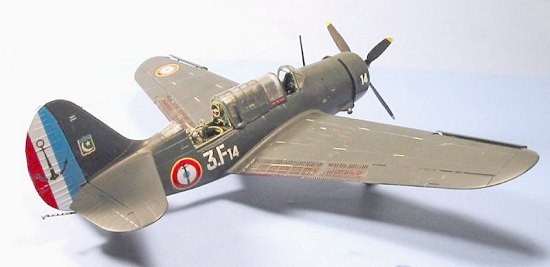 In early 1944, the
SB2C-3 appeared, powered by an up-rated R-2600 providing 1,900 h.p. with a
4-bladed prop; late production aircraft had their dive flaps modified to a
perforated type, which helped alleviate the buffeting and lack of directional
control in a dive suffered by the SB2C-1 and early SB2C-3. The 4 machine gun
wing armament of the SB2C-1 was replaced by one 20mm cannon in each wing.
In early 1944, the
SB2C-3 appeared, powered by an up-rated R-2600 providing 1,900 h.p. with a
4-bladed prop; late production aircraft had their dive flaps modified to a
perforated type, which helped alleviate the buffeting and lack of directional
control in a dive suffered by the SB2C-1 and early SB2C-3. The 4 machine gun
wing armament of the SB2C-1 was replaced by one 20mm cannon in each wing.
By the time the SB2C-4 appeared in the summer of 1944, the Navy was finally being provided the airplane all had hoped for in 1942. With perforated dive flaps, it could perform steep, accurate dives. Unfortunately, this was not a really superior airplane to the SBD Dauntless, which was much more controllable and actually a far better dive bomber. The lack of power even with the up-rated engine, combined with the controllability problems inherent in the design, led the aircrews to call it the "Sum Bitch 2nd Class," and "The Beast." There were at least three occasions when the Navy considered abandoning the Helldiver program altogether, a decision that was aborted only because of the vast investment in production resources represented by the Helldiver, as well as the lack of a suitable alternative.
The Helldiver was additionally the shortest-ranged strike aircraft in the Navy, a point driven home in the "Mission Beyond Darkness" during the First Battle of the Philippine Sea, when all SB2C-1 and SB2C-3 aircraft launched at extreme range against the Japanese carriers were lost due to lack of range on the return flight.
What eventually drove the Helldiver from the flight decks was the "Kamikaze." The Navy needed to double the size of their fighter squadrons to provide adequate fleet defense against the suicide attackers. The F4U-1D and F6F-5 fighters were now capable of flying fighter-bomber missions in addition to their role as fleet defense fighters, with higher ordnance loads and better performance than the SB2C was capable of. By early 1945, those SB2C squadrons still aboard the fleet carriers were reduced to 10 aircraft each; when fighter squadrons were increased from 73 to 92 aircraft, the bombing squadrons were entirely replaced.
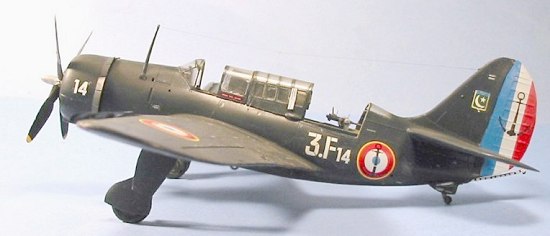 The SB2C was
credited with 44 confirmed victories in aerial combat. LT Robert B. Parker of
VB-19 was the top-scorer, with 3 Japanese fighters shot down while operating
from "Lexington" in the fall of 1944. The most successful gunners were ARM3/c
E.J. Elias of VB-14, and ARM3/c S.E. Wallace of VB-17, with two each. 17 SB2Cs
were lost to Japanese fighters during the war.
The SB2C was
credited with 44 confirmed victories in aerial combat. LT Robert B. Parker of
VB-19 was the top-scorer, with 3 Japanese fighters shot down while operating
from "Lexington" in the fall of 1944. The most successful gunners were ARM3/c
E.J. Elias of VB-14, and ARM3/c S.E. Wallace of VB-17, with two each. 17 SB2Cs
were lost to Japanese fighters during the war.
The last major mission in which the SB2C formed a significant part of the total strike force was the Tokyo strikes by Task Force 38 in February, 1945. The last significant mission of the SB2C were the strikes flown by SB2Cs of VB-82 aboard the "Bennington," against the Japanese battleship "Yamato" in May 1945.
The final version of the Helldiver - the SB2C-5 - flew combat missions during the Greek Civil War in 1948-50 with the Greek Air Force, and in Vietnam in 1951-54 with the French Aeronavale. Flotille 3F, operating from the French carrier "Arromanches" - a former U.S. light fleet carrier the U.S. Navy had deemed too small to safely handle "The Beast" - flew close air support missions for French forces throughout Indochina during two cruises between 1951 and 1954; their missions flown in support of the besieged garrison of Dien Bien Phu in the Spring of 1954 were not only the last combat missions flown by the SB2C, but were among the most effective dive-bombing missions ever flown by the "Helldiver."
|
THE KIT |
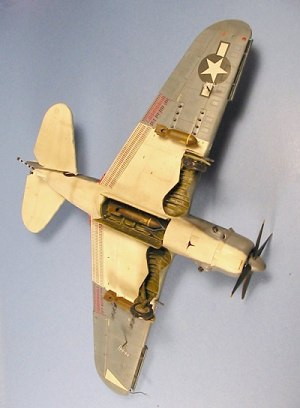 "The Beast" has been
produced in four different kits I am aware of, the first being an SB2C in 1/48
from Monogram that came out in 1961; this was more a toy than a scale model,
with folding wings, etc. It was also extremely inaccurate in outline, with
the wing far too narrow in chord; this was due to technology limitations at
the time of the percentage of area that could be machined out of the block of
steel. There was also an SB2C of uncertain sub-type issued in 1/72 by Aoshima
in the 1960s. The first kit with any outline accuracy was the 1/72 Airfix kit
issued in 1969, which is still available. In the 1970s, Modeltoy released an
SB2C-1 - the only model ever made of this sub-type - in 1/72. (Editor's
Note: I think Matchbox also did a -SB2C-1) Thus, when Monogram announced
in 1997 that they would release a 1/48 SB2C through their ProModeler line, it
was eagerly anticipated.
"The Beast" has been
produced in four different kits I am aware of, the first being an SB2C in 1/48
from Monogram that came out in 1961; this was more a toy than a scale model,
with folding wings, etc. It was also extremely inaccurate in outline, with
the wing far too narrow in chord; this was due to technology limitations at
the time of the percentage of area that could be machined out of the block of
steel. There was also an SB2C of uncertain sub-type issued in 1/72 by Aoshima
in the 1960s. The first kit with any outline accuracy was the 1/72 Airfix kit
issued in 1969, which is still available. In the 1970s, Modeltoy released an
SB2C-1 - the only model ever made of this sub-type - in 1/72. (Editor's
Note: I think Matchbox also did a -SB2C-1) Thus, when Monogram announced
in 1997 that they would release a 1/48 SB2C through their ProModeler line, it
was eagerly anticipated.
The anticipation paid off with the release of the kit in 1998. The particular sub-type was the "definitive" SB2C-4 used by the Navy in World War II. Built out of the box, the kit was dimensionally accurate overall, and provided a detailed pilot's and gunner's cockpit, with photoetch perforated dive brakes, and very nice engraved surface detail. The kit decals provided two aircraft: a VB-3 aircraft aboard USS "Yorktown" for the Tokyo strikes, in the tri-color camouflage scheme, and an overall Glossy Sea Blue Helldiver from VB-84 aboard USS "Bunker Hill" at the same time period. The bomb bay could be assembled in the open position, the engine was sufficiently detailed for all but the "engine nuts", and the two canopies could be posed open. The only thing one couldn't make straight from the box was a Helldiver with the rear turtleback open for deployment of the rear guns.
Being the kind of modeler I sometimes am, I decided I would build my SB2C-4 with the turtleback lowered. When the kit was released by Revell of Germany in Europe with markings for an SB2C-5 used by the Aeronavale, I decided I would modify the kit to the SB2C-5 sub-type. Neither of these conversions is particularly difficult.
|
CONSTRUCTION |
 These two Helldivers
in this article are actually the second and third kits of the type I built.
On the first one, I discovered the hard way that the best way to begin
assembly was to assemble the wings, and then attach them to the fuselage
halves before further assembly of the fuselage. The reason for doing so is
because of the way the wing attaches to the fuselage; it is a non-standard
attachment that really works best of one can work on the glue joint from both
inside and outside the fuselage, to press the wing into the joint and assure
it is tight and at the right dihedral angle.
These two Helldivers
in this article are actually the second and third kits of the type I built.
On the first one, I discovered the hard way that the best way to begin
assembly was to assemble the wings, and then attach them to the fuselage
halves before further assembly of the fuselage. The reason for doing so is
because of the way the wing attaches to the fuselage; it is a non-standard
attachment that really works best of one can work on the glue joint from both
inside and outside the fuselage, to press the wing into the joint and assure
it is tight and at the right dihedral angle.
Once you have assembled the wings to the fuselage halves, you can proceed with the rest of the assembly following the kit's instructions. There are no insuperable difficulties, due to the excellent production design.
Conversion #1 - Lowering
The Turtleback:
This conversion starts with cutting off the folding area of the turtleback aft of the gunner's cockpit before doing anything else to the fuselage halves. This is simple, requiring use of a razor saw and a #11 X-acto blade, and all you have to do is follow the engraved detail.
Once you have this removed, cut off the sides from the upper section of the turtleback. Assemble those halves, and attach the canopy glass part. Then - using .015 plastic sheet, make the four folding pieces of the side of the turtleback, using the parts you cut off as a guide for size.
After the model has been painted and assembled, you can attach the turtleback in the folded position, as shown in the photograph here. This is a simple conversion, and gives the model a very distinctive "look," as you can see here.
Conversion #2 - Turning the SB2C-4 Into An SB2C-5:
There are three major differences between the SB2C-4 and SB2C-5 that modelers need to be worried about. These are the different prop used, the clear canopy over the pilot's cockpit, and the different internal layout of the pilot's cockpit.
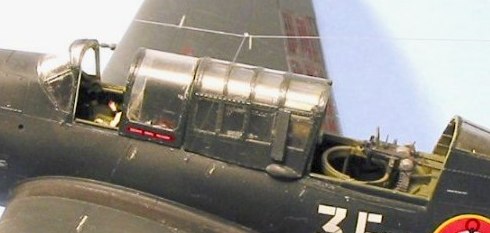 Of these, the only
one that will take any time is the scratchbuilt conversion of the cockpit.
Get rid of most of the sidewall detail that comes with the kit, other than the
internal ribs that will be fixable above the two side consoles you will
construct from Evergreen sheet. I have never seen a full photo of the
interior of the cockpit of the SB2C-5, but the description of it in the Detail
and Scale book says "a very neat, modern layout, similar to other late war
cockpits." With the side consoles, and a throttle on the console, a trim
wheel on the left console, other dials and switches placed in what are the
likely positions, one can come up with an approximation of this, and it is
very unlikely the Cockpit Polizei will be able to present evidence of your
guilt in failing to Do It Right.
Of these, the only
one that will take any time is the scratchbuilt conversion of the cockpit.
Get rid of most of the sidewall detail that comes with the kit, other than the
internal ribs that will be fixable above the two side consoles you will
construct from Evergreen sheet. I have never seen a full photo of the
interior of the cockpit of the SB2C-5, but the description of it in the Detail
and Scale book says "a very neat, modern layout, similar to other late war
cockpits." With the side consoles, and a throttle on the console, a trim
wheel on the left console, other dials and switches placed in what are the
likely positions, one can come up with an approximation of this, and it is
very unlikely the Cockpit Polizei will be able to present evidence of your
guilt in failing to Do It Right.
The canopy is easy: sand off the frames, sand the canopy as smooth as possible, then dip it in Future. Voila! An SB2C-5 canopy.
For the prop, I used a P-47N prop from an Academy P-47N that had "bitten the dust." Alternatively, you can take the paddle blades for the Curtiss-Electric prop from the Hasegawa Thunderbolt, re-shape them just a bit to emphasize the paddle above the cuffs, and attach these to the hub of the kit propeller. The extended hub of the kit prop is too short, so you will need to use something (I generally use 5" rockets) to extend the prop hub.
I also decided to close the bomb bay for this kit, since the SB2C-5 bomb bay is longer than that of the SB2C-4. Once I puttied it over and smoothed it out, I rescribed an appropriately-sized bomb bay.
|
CAMOUFLAGE & MARKINGS |
Scheme 1: Tri-color SB2C-4
I had the Aeromaster sheet for a VB-3 Helldiver, similar to that of the airplane the kit decals portray, though of better quality. Rather than use decals for the triangle ID for Yorktown aircraft, I painted that area white on the rudder and the wings, and then masked them off. I used Gunze-Sangyo "Navy Blue" for the Non-specular Sea Blue, Gunze-Sangyo "Intermediate Blue", and Tamiya flat white with a brush full of black in the paint bowl to lower the reflectivity and brightness of the white. I went over each upper surface color after adding a bit of white to the original color, to "fade" the scheme. Lastly, I "post shaded" the model with thinned Tamiya "Smoke" over all the panel lines.
I used the kit decals for all the stenciling, and the Aeromaster decals for the national markings and squadron insignia.
Scheme 2: Overall Glossy Sea Blue SB2C-5:
 Photos of the
Helldivers used by 3 Flotille in Vietnam show that the airplanes had
originally been US Navy aircraft, and that the US markings were overpainted
with GSB rather than removed. I painted the model with Gunze-Sangyo "Midnight
Blue," then added in some Gunze-Sangyo "Navy Blue" and went over various areas
to "weather" the GSB (this is a very tough paint - which is why the Navy used
it - and it weathers by going flat, not so much by getting any lighter,
according to photos). I did put in a drop of white and go over the surfaces
most exposed to sunlight, particularly the fabric-covered control surfaces, at
the end. I then used national insignia decals that were trimmed very closely,
and applied them in the proper positions. When these were dry, I overpainted
them with a thin coat of "Midnight Blue," so that one can see (in person) the
outline of the insignia through the paint.
Photos of the
Helldivers used by 3 Flotille in Vietnam show that the airplanes had
originally been US Navy aircraft, and that the US markings were overpainted
with GSB rather than removed. I painted the model with Gunze-Sangyo "Midnight
Blue," then added in some Gunze-Sangyo "Navy Blue" and went over various areas
to "weather" the GSB (this is a very tough paint - which is why the Navy used
it - and it weathers by going flat, not so much by getting any lighter,
according to photos). I did put in a drop of white and go over the surfaces
most exposed to sunlight, particularly the fabric-covered control surfaces, at
the end. I then used national insignia decals that were trimmed very closely,
and applied them in the proper positions. When these were dry, I overpainted
them with a thin coat of "Midnight Blue," so that one can see (in person) the
outline of the insignia through the paint.
I used the Revell
of Germany decals for the Aeronavale 3 Flotille SB2C-5, which
were kindly sent to me by a British modeler friend.
|
FINAL CONSTRUCTION |
The rear turrets of both models were installed after the model was assembled and finished. I also attached the main landing gear, propellers and canopies at this time. I used clear nylon repair thread for the antenna wires.
|
CONCLUSIONS |
The SB2C definitely looks like a "Beast." It may not have been the best dive bomber the Navy ever used, but it was an important participant in the great campaigns of the Pacific War and fully deserving of a place in any representative Naval aircraft collection. At a price of around US$20, depending on where you purchase it, it is excellent value for the money.
Kits supplied courtesy
of my wallet.
March 2003
If you would like your product reviewed fairly and quickly by a site that has nearly 200,000 visitors a month, please contact me or see other details in the Note to Contributors.
Back to the Reviews Index Page